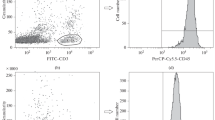Summary
The blood lymphocyte population of 118 patients with primary intracranial tumours and healthy volunteers was examined with respect to its size and cellular composition using various rosette tests. The patients had not undergone any surgical intervention or received any treatment with ionizing irradiation or cytotoxic drugs. However, some of them were treated with corticosteroids.
It was observed that non-steroid treated patients with oligodendrogliomas, but not patients with other histological types of tumours, had a significantly reduced proportion of “active” T-lymphocytes forming rosettes with sheep erythrocytes (a type of T-lymphocyte which is activated by foetal calf serum). These patients as well as those with astrocytomas, malignant gliomas (anaplastic astrocytomas and glioblastomas) or miscellaneous tumours (mainly meningiomas) had normal proportions of lymphocytes with receptors for the Fc-part of IgG or C'3 and cells forming rosettes with sheep erythrocytes under more conventional conditions. Patients who were treated with corticosteroids had an increased frequency of lymphocytes with the above Fc-receptor.
An association between site of the lesions and cellular composition of the blood lymphocyte population was not detected. The results give further support for the view that the immunological system may be changed in patients with oligodendrogliomas.
Similar content being viewed by others
References
Brooks WH, Netsky MG, Normansell DE, Horwitz DA (1972) Depressed cell-mediated immunity in patients with primary intracranial tumors. Characterization of a humoral immunosuppressive factor. J Exp Med 136: 1631–1647
Brooks WH, Caldwell HD, Mortara RH (1974) Immune responses in patients with gliomas. Surg Neurol 2: 419–423
Menzies CG, Gunar M, Thomas DTG, Behan PO (1980) Impaired thymus-derived lymphocyte function in patients with malignant brain tumors. Clin Neurol Neurosurg 82: 157–168
Brooks WH, Roszman TL, Rogers AS (1976) Impairment of rosette-forming T-lymphocytes in patients with primary intracranial tumors. Cancer 37: 1869–1893
Mahaley MS, Brooks WH, Roszman TL, Bigner DD, Dudka L, Richardsson S (1977) Immunobiology of primary intracranial tumors. I. Studies of the cellular and humoral general immune competence of brain tumor patients. J Neurosurg 46: 467–476
Roszman TL, Brooks WH (1980) Immunobiology of primary intracranial tumors. III. Demonstration of a qualitative lymphocyte abnormality in patients with primary brain tumors. Clin Exp Immunol 39: 395–402
Neuwelt EA, Kikuchi K, Hill S, Lipsky P, Frenkel EP (1983) Immune response in patients with brain tumors. Factors such as anticonvulsants may contribute to impaired cell-mediated immunity. Cancer 51: 248–255
Braun DP, Penn RD, Flannery AM, Harris JE (1982) Immunoregulatory cell function in peripheral blood leukocytes of patients with intracranial gliomas. Neurosurg 10: 203–209
Brooks WH, Roszman TL, Mahaley MS, Woosley RE (1977) Immunobiology of primary intracranial tumors. II. Analysis of lymphocyte subpopulations in patients with primary brain tumors. Clin Exp Immunol 29: 61–66
Kril MP, Apuzzo MLJ (1983) Observations on the study of T-lymphocyte subsets by monoclonal antibodies and flow cytometric analyses in intracranial neoplastic disorders. Clin Neurosurg 30: 125–136
Brooks WH, Latta RB, Mahaley MS, Roszman TL, Dudka L, Skaggs C (1981) Immunobiology of primary intracranial tumors. Part 5: Correlation of a lymphocyte index and clinical status. J Neurosurg 54: 331–337
Renoux G, Biziere K, Renoux M, Guillaumin JM (1983) The production of T-cell inducing factors in mice is controlled by the brain neocortex. Scand J Immunol 17: 45–50
Zülch KJ (1977) International histological classification of tumors. No 21. Histological typing of tumors of the central nervous system. Geneva, World Health Organization
Blom U, Blomgren H, Ullén H, Collins P, von Holst H (1985) Mitogen stimulation of blood lymphocytes from patients with primary intracranial tumors. Correlation to histological tumor type. Anticancer Research 5: 343–348
Blomgren H, Blom U, Ullén H (1986) Relation between the site of primary intracranial tumors and mitogenic responses of blood lymphocytes. Cancer Immunol 21: 31–38
Bøyum A (1968) Isolation of mononuclear cells and granulocytes from human blood. Isolation of mononuclear cells by one centrifugation. Scand J Clin Lab Invest 97: 77–89
Blomgren H (1974) Steroid sensitivity of the response of lymphocytes to phytohemagglutinin and poke weed mitogen. Role of phagocytic cells. Scand J Immunol 3: 655–664
Jondal M, Holm G, Wigzell H (1972) Surface markers on human B and T lymphocytes. A large population of lymphocytes forming non-immune rosettes with sheep red blood cells. J Exp Med 136: 207–215
Horowitz T, Groshong R, Albrecht L, Hong R (1975) The “active” rosette test in immunodeficiency diseases. Clin Immunol Immunopathol 4: 405–414
Blomgren H (1979) Characterization of lymphocytes which inhibit proliferation of human T-cells exposed to lymphocyte-derived mitogenic factors. Int Arch Allergy Appl Immunol 59: 192–198
Blomgren H, Blom U, Ullén H (1985) Capacity of sera from patients with primary intracranial tumors to support mitogen stimulation of blood lymphocytes. Correlation to histological tumor type. Anticancer Research 5: 349–354
Isaković K, Janković BD (1973) Neuroendocrine correlates of immune response. II. Changes of lymphatic organs of brain-lesioned rats. Int Arch Allergy 45: 373–384
Oger J (1982) A monoclonal antibody against T-suppressor lymphocytes binds specifically to the surface of cultured oligodendrocytes. Nature 295: 66–68
Author information
Authors and Affiliations
Rights and permissions
About this article
Cite this article
Ullén, H., Blom, U., Blomgren, H. et al. Blood lymphocyte subsets in patients with primary intracranial tumours. Correlation to histological tumour type and anatomical site. Acta neurochir 81, 100–105 (1986). https://doi.org/10.1007/BF01401229
Issue Date:
DOI: https://doi.org/10.1007/BF01401229




